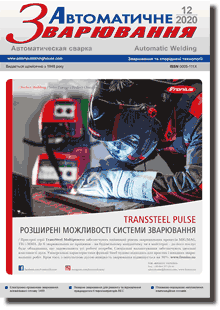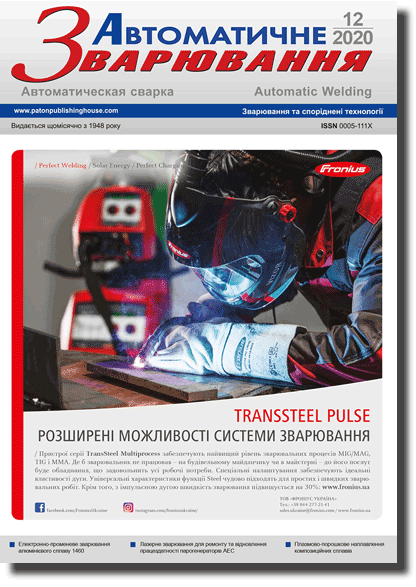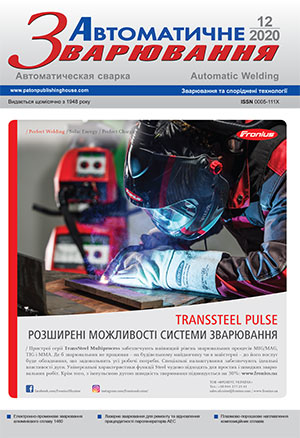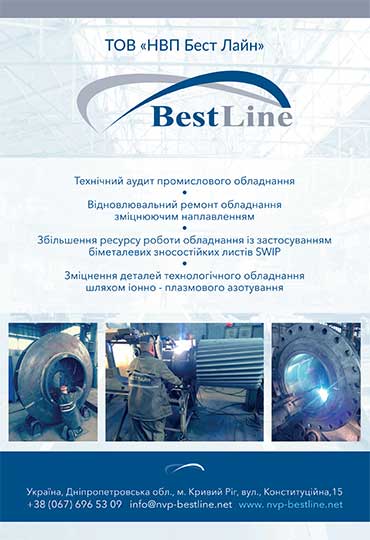| 2020 №12 (07) |
DOI of Article 10.37434/as2020.12.01 |
2020 №12 (02) |

"Avtomatychne Zvaryuvannya" (Automatic Welding), #12, 2020, pp. 3-16
Impact of technological parameters of arc deposition of an anti-corrosion layer in the vessel of WWER-1000 reactor on residual stress distribution
O.V. Makhnenko, O.S. Kostenevich
E.O. Paton Electric Welding Institute of the NAS of Ukraine. 11 Kazymyr Malevych Str., 03150, Kyiv, Ukraine. E-mail: office@paton.kiev.ua
Substantiation of extension of safe operating life of the vessels of WWER-1000 reactors in service requires taking into account the residual stresses, arising during fabrication as a result of heating at welding or surfacing and their redistribution after heat treatment. Automatic submerged-arc surfacing with strip electrodes was used for the cylindrical part of the vessels, and manual coated-electrode arc surfacing was applied for the nozzle zone surface (internal surface of nozzles Dn850 and their fillets), as well as other difficult-of-access places of the vessel. The process and parameters of the mode of anticorrosion arc surfacing can markedly influence the microstructural phase composition of the HAZ of base material, 15Kh2NMFA vessel steel, as well as residual stress distribution. Mathematical modeling was used for prediction of microstructural phase transformations in the HAZ at deposition of the protective anticorrosion layer; based on experimental welding thermokinetic diagram of austenite decomposition of 15Kh2NMFA vessel steel, distribution of residual stresses in WWER-1000 reactor vessel was derived, allowing for microstructural transformations at different technological modes of arc surfacing. Comparison of the results of residual stress distribution after deposition and heat treatment at different technological modes showed presence of a zone of compressives, which arise in the HAZ of 15Kh2NMFA steel, as a result of martensite-bainite transformation. 24 Ref., 6 Tabl., 15 Fig.
Keywords: reactor vessel, WWER-1000, anticorrosion arc surfacing, heat-treatment, residual stresses, microstructural phase transformations, mathematical modeling, thermokinetic diagram, 15Kh2NMFA steel
Received: 02.11.2020
References
1. (2003) PNAE G-7-009-89: Equipment and pipelines of nuclear power plants. Welding and surfacing, basic provisions. Moscow [in Russian].2. (1982) Welded vessel 1152.02.70.000. Appendix to pressure vessel certificate 1152.02.70.000 D7, ZNPP, bl. 1 [in Russian].
3. Titova, T.I.,Shulgan, N.A. (2013) Improvement of quality of welded joints and deposited surfaces of NPP equipment OJSC production "Izhorskie zavody". In: Proc. of Conf. on Ensuring the Safety of NPP with WWER, St.-Petersburg, Gidropress [in Russian]. http://www.gidropress.podolsk.ru/files/proceedings/mntk2013/autorun/article95ru.htm
4. Iradj, Sattari-Far, Magnus, Andersson (2006) Cladding effects on structural integrity of nuclear components. SKI Report 2006:23, ISSN 1104-1374, ISRN SKI-R-06/23-SE.
5. Katsuyama, J., Udagawa, M., Nishikawa, H. et al. (2010) Evaluation of weld residual stress near the cladding and j-weld in reactor pressure vessel head for the assessment of PWSCC behavior. Japan Society of Maintenology. E-J. of Advanced Maintenance, 2, 50-64.
6. Dupas, P., Moinereau, D. (1996) Evaluation of cladding residual stresses in clad blocks by measurements and numerical simulations. J. de Physique IV Colloque, 6, 187-196. https://doi.org/10.1051/jp4:1996118
7. Ryabtsev, I.A., Senchenkov, I.K. (2013) Theory and practice of surfacing operations. Kiev, Ekotekhnologiya [in Russian].
8. Tsvitanovich, M., Postruzin, Zh., Munk, R. et al. (2011) System of ultrasonic testing of reactor vessel metal of Kudankulam NPP. In: Proc. of Conf. on Ensuring the Safety of NPP with WWER, Podolsk, Gidropress [in Russian]. http://www.gid-ropress.podolsk.ru/files/proceedings/mntk2011/documents/mntk2011-184.pdf
9. Margolin, B.Z., Varovin, A.Ya., Kostylyov, V.I. (2005) Determination of residual stresses in the WWER vessels after multi-run welding, surfacing and high-temperature tempering. The Paton Welding J., 10, 14-20.
10. (1978) TU 108-765-78: Billets of steel of 15Kh2NMFA and 15Kh2NMFA-A grades for vessels and covers and other assemblies of reactor plants.
11. Kostylev, V.I., Margolin, B.Z. (2000) Determination of residual stress and strain fields caused by cladding and tempering of reactor pressure vessels. Int. J. of Pressure Vessels and Piping, 77, 723-735. https://doi.org/10.1016/S0308-0161(00)00062-4
12. (2000) Procedure for determination of service life of nuclear reactor vessels during operation (MRK-SKhR-2000), RD EO 0353-02, St.-Petersburg-Moscow [in Russian].
13. Makhnenko, O.V., Kostin, V.A., Zhukov, V.V., Kostenevich, E.S. (2019) Effect of cooling cycle of welding on structure- phase composition of 15Kh2NMFA steel. The Paton Welding J., 9, 8-17. https://doi.org/10.15407/tpwj2019.09.02
14. Hrivnak, I. (1984) Weldability of steels. Ed. by E.L. Makarov. Moscow, Mashinostroenie [in Russian].
15. Kasatkin, O.G., Seyffarth, P. (2002) Calculation models for evaluating mechanical properties of HAZ metal in welding low-alloyed steels. In: Proc. of Int. Conf. on Mathematical Modeling and Information Technologies in Welding and Related Processes. Kiev, 103-106.
16. Kasatkin, O.G. (1990) Mathematical modeling of relations composition-properties of welded joints and development of calculation and experimental system for optimization of main technological factors for welding of low-alloyed structural steels. In: Syn. of Thesis for Dr. of Tech. Sci. Degree, Kiev, PWI [in Russian].
17. Lobanov, L.M., Kostin, V.А., Makhnenko, O.V. et al. (2020) Forecasting of structural transformations in heat affected zone steel of 15KH2NMFA at anti-corrosion cladding. Problems of Atomic Science and Technology, 2, 126, 89-96.
18. Gurovich, B.A., Kuleshova, E.A., Fedotova S.V. (2011) Influence of chemical composition and structural parameters of steels of WWER reactor vessels on susceptibility to embrittlement caused by formation of grain boundary segregations including the conditions characteristic for long-term operation of power plants. In: Proc. of 7th Int. Sci.-Techn.Conf. on Ensuring the Safety of NPP with WWER, Podolsk, Gidropress. http://www.gidropress.podolsk. ru/files/proceedings/mntk2011/autorun/article151-ru.htm
19. Frolov, A.S. (2013) Phase-structural state and service characteristics of new steel compositions for reactor vessels of higher power and service life. In: Syn. of Thesis for Cand. of Tech. Sci. Degree, Moscow, NRC Kurchatov Institute [in Russian].
20. Teplukhina, I.V., Golod, V.M., Tsvetkov, A.S. (2018) CCT diagram plotting based on the numerical analysis of dilatometric tests results. Letters on Materials, 8, 1, 37-41. https://doi.org/10.22226/2410-3535-2018-1-37-41
21. Soloviov, I.V., Kornienko, O.Yu., Zhilyakov, A.Yu., Belorusets, A.M. (2017) Examination of kinetics of overcooled austenite decomposition of 15Kh2NMFA steel during continuous cooling. In: Proc. of 18th Int. Sci.-Techn. Ural School-Seminar of Metallurgists-Junior Scientists (Ekaterinburg, 21-23 November 2017), UrFU, 250-252.
22. Makhnenko, V.I. (1976) Calculation methods of investigation of welding stresses and strains. Kiev, Naukova Dumka [in Russian].
23. Makhnenko, V.I. (2006) Safe service life of welded joints and assemblies of modern structures. Kiev, Naukova Dumka
24. Betton, J. (2008) Creep Mechanics. 3-rd ed. Springer, Germany, XVI.
Advertising in this issue:
The cost of subscription/purchase order journals or individual articles
| Journal/Currency | Annual Set | 1 issue printed |
1 issue |
one article |
| TPWJ/USD | 384 $ | 32 $ | 26 $ | 13 $ |
| TPWJ/EUR | 348 € | 29 € | 24 € | 12 € |
| TPWJ/UAH | 7200 UAH | 600 UAH | 600 UAH | 280 UAH |
| AS/UAH | 1800 UAH | 300 UAH | 300 UAH | 150 UAH |
| AS/USD | 192 $ | 32 $ | 26 $ | 13 $ |
| AS/EUR | 180 € | 30 € | 25 € | 12 € |
| SEM/UAH | 1200 UAH | 300 UAH | 300 UAH | 150 UAH |
| SEM/USD | 128 $ | 32 $ | 26 $ | 13 $ |
| SEM/EUR | 120 € | 30 € | 25 € | 12 € |
| TDNK/UAH | 1200 UAH | 300 UAH | 300 UAH | 150 UAH |
| TDNK/USD | 128 $ | 32 $ | 26 $ | 13 $ |
| TDNK/EUR | 120 € | 30 € | 25 € | 15 € |
AS = «Automatic Welding» - 6 issues per year;
TPWJ = «PATON WELDING JOURNAL» - 12 issues per year;
SEM = «Electrometallurgy Today» - 4 issues per year;
TDNK = «Technical Diagnostics and Non-Destructive Testing» - 4 issues per year.









